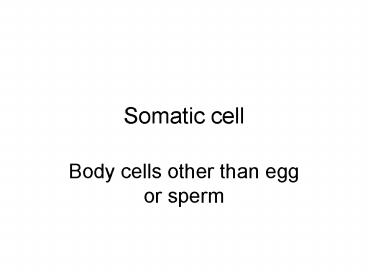Somatic cell PowerPoint PPT Presentation
1 / 48
Title: Somatic cell
1
Somatic cell
- Body cells other than egg or sperm
2
Chromosome Number is fixed in each species
3
Sexual Reproduction
- Combining the monoploid chromosomes of two
individuals to make a new diploid organism
4
sperm
- Male gamete
5
egg
- Female gamete
6
Pollination
- Male pollen is combined with female ovules to
form embryo-seed
7
zygote
- Fertilized egg or gamete
8
meiosis
- Chromosome division for production of monoploid
or haploid cells
9
tetrad
- Chromosome arrangement in prophase of meiosis-
homologous pairs lie side by side in synapsis
10
- Gene- a single unit of inheritance
- Gene map- show the location of genes on a
chromosome - Gene linkage- when genes are located near each
other on a chromosome
11
Principles of Heredity
- Alternative versions of genes (alleles) account
for variations in a trait. - For each character, an organism inherits two
alleles, one from each parent. - If alleles differ, then the dominant will be
fully expressed over the recessive. - The two alleles segregate (separate) during
gamete formation. - Alleles on different chromosomes segregate
independently of one another
12
segregation
- Genes( alleles) separate on chromosomes during
anaphase of meiosis
13
Independent assortment
- Gene alleles separated independently on
homologous chromosome during anaphase of meiosis
14
Genetic recombination
- Genes come together in a random fashion as
chromosomes pair following fertilization
15
Gametes- sex cells---egg, sperm or pollen
- Monoploid or haploid
- Half of the diploid number
16
allele
- An alternate form of a gene
- A a
- B b
17
Alleles
- Dominant
- Yellow seeds
- Axial flowers
- Tall Plants
- Smooth seeds/Round
- Recessive
- Green seeds
- Terminal flowers
- Short Plants
- Wrinkled Seeds
18
Punnet Square
- Shows a genetic cross between two individuals
alleles
19
dominant
- A gene which can express itself when in the
presence of a recessive
20
Recessive
- A gene which is unable to express itself when
with a dominant - Can only be expressed when homozygous recessive
21
Homozygous
- Both alleles are the same either both dominant or
both recessive
22
Heterozygous
- Both of the alleles are different
- One dominant and one recessive
23
Genotype
- Actual gene present
- Not visible
- AA, Aa, aa
24
Phenotype
- The expression of a genotype, what is seen in the
individual - eye color
- hair color
- disease present
25
Mendel
- Made genetics quantifiable
- Experimental crosses
- Character- detectable inherited feature
- Trait-variation of a character
26
- True breeding or pure bred- always produced the
same trait - Hybrids produced different variants
- WHY
27
Autosomal Complete Dominance
b
b
- One gene is able to dominate the other recessive
allele - Example all offspring express B as black fur over
b white
B
Bb
Bb
B
Bb
Bb
All black offspring
28
Autosomal Recessive Pattern
Gene is unable to express itself unless it is in
a homozygous condition.
29
Incomplete dominance- heterozygotes are
intermediate in expression
B
B
B
In this cross BB results in black fur, BB
results in white fur, and BB results in gray.
BB
BB
B
BB
BB
30
CODOMINANCE- each gene of the allele is expressed
iA
iA
The A,B, O Blood type shows Codominance genotypes
iAiA, iBiB, iOiO, iAiB, iAiO ,and iAiO
iAiB
iAiB
iB
iAiB
iAiB
iB
31
Multiple Alleles
- In this pattern more than two alleles are
possible for a trait. - Blood Groups or types are an example of this
also.
32
Test Cross- used to determine the genotype of an
unknown
- If a dominant trait is expressed how could you
tell if the individual is heterozygous or
homozygous - Cross the unknown with a homozygous recessive and
if the ratio is 50/50 you can be certain the
unknown was heterozygous
33
Polygenic
- More than one pair of genes control the trait
- Genes working together
- Expression is varied
- Race is an example
- Most common form of inheritance
34
Polygenic Inheritance
- Additive effect of two or more genes on
phenotypic expression - Phenotypic expression varies along a continuum
- Skin and eye pigmentation
35
Multifactorial
- Influenced by both environment and heredity.
36
- Sex or X linked
- Inheritance- genes that are carried on the X
chromosome
37
Sex-Linked Disorders
- Genes carried on the X chromsome
- Males only have one- more likely to have trait
- Females can be carriers
- Most important diseases are recessive
- Red-green color blindness, hemophilia
38
Nondisjunction
- Chromosomes fail to separate properly during
meiosis. - Age is a factor
- results in Downs Syndrome
- results in Turners Syndrome
- results in Klinefelters Syndrome
39
Aneuploidy
- Too many or too few chromosomes.
40
Mutations-any sudden change in genetic material
that can be passed on to the next generation
41
Deletion
- A fragment of a chromosome is missing
- ex. Cri-du-chat syndrome or deletion of the short
arm of the b group - chromosome results in a sever form of autism
42
Translocation- exchange of genetic material from
one location on a chromosome to another
non-homologous chromosome.
Ex. D_G translocation causes a form of
Downs Syndrome
43
Chromosomes
- Autosomes
- First 44
- Same for male as female
- Sex Chromosomes
- Determine sex
- XX or XY
44
Mutations-any sudden change in genetic material
that can be passed on to the next generation
45
Translocation- exchange of genetic material from
one location on a chromosome to another
non-homologous chromosome.
Ex. D_G translocation causes a form of
Downs Syndrome
46
- Amniocentesis-withdraw amniotic fluid ( amniotic
sac )14th-16th week
47
- chorionic vili sampling biopsy remove a piece of
chorionic (fetal/maternal) tissue
48
Ultrasonography
- Use of Ultrasound, sonar to determine shape and
position of fetus

